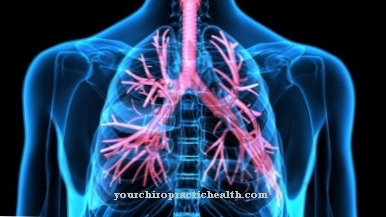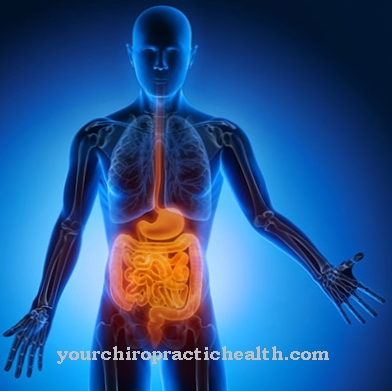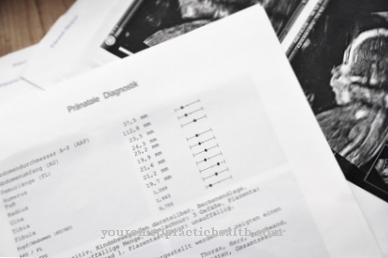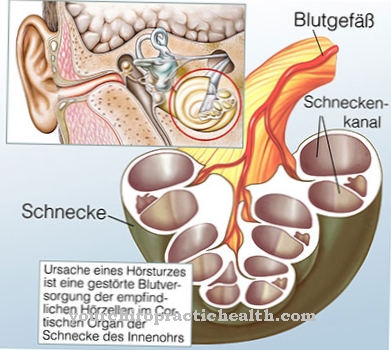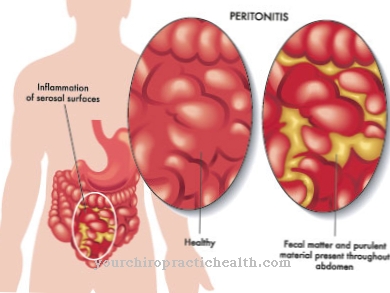In which Ehlers-Danlos Syndrome, also known as EDS, are connective tissue disorders that are inherited as part of a genetic defect. Above all, the EDS manifests itself through hypermovable joints as well as overstretchability of the skin. Occasionally, vessels, ligaments, muscles, tendons and internal organs can also be affected by EDS; the prognosis depends on what type of syndrome was diagnosed.
What is Ehlers-Danlos Syndrome?

© Astrid Gast - stock.adobe.com
Ehlers-Danlos syndrome is a very rare connective tissue disease. It is an inherited disease that occurs as part of a genetic defect. There is a collagen synthesis disorder. Because the connective tissue is present throughout the body, the symptoms and signs of Ehlers-Danlos syndrome can be very different and varied.
Sometimes the affected person can complain of overstretchable skin; in some cases there is even talk of rupture of the vessels and internal organs. There are ten types of EDS, which have different symptoms and courses.
causes
The Ehlers-Danlos syndrome is triggered by a genetic defect in collagen synthesis. Around 80 percent of all sick people suffer from types I to III, types IV to VII only make up a fraction of all sick people; Types VIII to X are even rarer. While types I and II of Ehlers-Danlos syndrome affect collagen V, type III is a collagen III disorder.
The following genes can trigger the Ehlers-Danlos syndrome: COL1A1 to COL3A1 as well as COL5A1 and COL5A2 and TNXB. Sometimes the ADAMTS2 and PLOD1 genes can also be responsible for the syndrome. Depending on the type, the mode of inheritance also depends. Many forms of Ehlers-Danlos syndrome are inherited as an autosomal dominant trait.
This means that only one of the alleles has to be affected by the change for Ehlers-Danlos syndrome to break out. But there are also forms that are inherited as an autosomal recessive trait. Both alleles must show a change so that the disease can be transmitted.
Symptoms, ailments & signs
Due to the collagen synthesis disturbance, the blood vessels, the skin and the joints are insufficiently developed. This means that the patient suffers from a lack of firmness and, as a consequence, from an overstretchability of the connective tissue. This leads to a slight tearing of the structures already affected. Above all, blood vessels can tear, spinal column curvatures or intestinal ruptures occur. Sometimes even a recurrent pneumothoraces is possible.
With types I and II, the patient complains of very easily injured and overstretchable skin. The wound healing process is very abnormal and the joints are very strong, and in some cases the blood vessels and internal organs can also be affected.
In type III, the skin is only partially affected by the disorder; Above all, those affected complain of an extremely pronounced overmobility of the joints. Type IV has very thin, almost translucent skin. The patient has a pronounced tendency to hematoma and also has extremely hypermovable joints, whereby at this stage the vessels and internal organs are often also affected by the Ehlers-Danlos syndrome.
Type VI primarily complains of moderate overstretchability of the skin. The wound healing is abnormal; sometimes internal organs are also involved. In many cases, there is also eye involvement. In type VII A and B, the skin is overstretchable, which is sometimes extremely thin. Many patients also complain of a hip dislocation. With type VII C, on the other hand, the patient reports sagging skin and involvement of his internal organs. The joints are also hypermovable.
Diagnosis & course
The doctor makes a clinical diagnosis, primarily referring to the family history. The doctor also checks the increased capillary fragility using the Rumpel-Leede test and also performs a skin biopsy, which is followed by an electron microscopic examination of the entire collagen structure. The types can be identified using human genetic DNA amplification.
Depending on the type, the prognosis and the course of the disease of Ehlers-Danlos syndrome vary. While some patients have very few limitations, others have problems in everyday life. Above all, pain, extreme joint instabilities and deformations of the spine mean that there is an enormous restriction in mobility.
The majority of patients, however, have a normal life expectancy; Only in very few patients who also suffer from impairment of the blood vessels do significant complications arise in the context of Ehlers-Danlos syndrome.
Complications
The complications in Ehlers-Danlos syndrome are highly dependent on the type diagnosed. In severe cases, the skin, muscles and ligaments are deformed. Internal organs can also be affected. Patients' skin is often overstretched and joints can move excessively.
Children in particular suffer greatly from Ehlers-Danlos syndrome due to bullying and teasing. This can lead to depression and psychological problems.
The skin can be damaged even by slight mechanical influences and is easy to tear. This increases the risk of accidents and inflammation.
The spine is also affected by Ehlers-Danlos syndrome, which can lead to curvatures of the spine. With all types there is sometimes abnormal wound healing, so that infections and inflammations must be treated with special care. Treatment or therapy is not possible with Ehlers-Danlos syndrome.
However, the patient must be careful not to perform any physically strenuous activities. Likewise, wounds and common colds must be treated with great care.The Ehlers-Danlos syndrome does not lead to a reduced life expectancy. Complications can arise primarily from curvature of the spine or delayed healing of wounds.
When should you go to the doctor?
A doctor should be consulted for frequent skin tears, abnormal wound healing, and other symptoms suggestive of impaired connective tissue. The Ehlers-Danlos syndrome also manifests itself as hematomas, excessively sensitive skin and sometimes spinal curvatures and intestinal ruptures. In the further course, hip problems and diseases of the internal organs can also occur. Immediate medical clarification is required for all of these complaints.
Since Ehlers-Danlos syndrome is a hereditary disease, it makes sense to take a look at the family history. Expectant parents who suffer from the disease themselves or have cases of the disease in their families should preferably have the child examined immediately after birth.
At the latest when serious complications such as bleeding or severe pain occur, a doctor must clarify the cause. Other contacts are the dermatologist, various internists or a specialist in hereditary diseases. In the event of a medical emergency, it is best to alert the ambulance service immediately or to take the person affected to the nearest hospital.
Doctors & therapists in your area
Treatment & Therapy
There is no symptomatic or causal therapy. For this reason, everything revolves around the prophylaxis of any consequential damage. The patient must take care to avoid injuries and major physical strain. This means that any sports that sometimes increase the risk of injury should be avoided.
The risk increases during pregnancy; especially people who are affected by types I, II, IV and VI must therefore undergo close monitoring. It is also important to have a cough suppressant therapy for colds. This is because a rupture of the large intestine and subsequently a pneumothorax can be prevented. If wounds occur, they must be carefully treated to encourage impaired wound healing.
Outlook & forecast
The prognosis for Ehlers-Danlos syndrome (EDS) depends on the type of disease. It is also different for each person affected. Patients with a hypermobile type of EDS usually have a normal life expectancy. With the vascular type of EDS, there is a greater risk of complications caused by sudden internal bleeding. In both forms, however, the quality of life is severely impaired.
Furthermore, both forms of Ehlers-Danlos syndrome contain several hereditary diseases of the connective tissue. Therefore, no causal therapy is currently possible. Even the options for symptomatic therapy are limited. It is therefore important for patients to take care not to suffer any injuries. Even mundane operations should not be performed to avoid injury. However, there are patients who hardly suffer from limitations. Others are severely impaired in their daily life.
Overall, the Ehlers-Danlos syndrome is progressive. In the course of life, the restrictions increase. Joint instabilities, spinal deformations and severe pain can occur, which greatly reduce mobility. In the vascular form of the disease, there is also a constant risk that blood vessels will rupture, leading to a life-threatening complication. The worst consequence of EDS, however, is the severe impairment of quality of life due to reduced mobility and the constant fear of painful ruptures.
prevention
There is no prevention. Sometimes only examinations as part of a pre-implantation diagnosis or a polar body diagnosis can prevent the inheritance of Ehlers-Danlos syndrome.
Aftercare
With Ehlers-Danlos syndrome, the person affected usually has very few or even no follow-up measures available. Since this is a congenital disease, it cannot be treated causally, but only symptomatically, so that a complete cure cannot occur. For this reason, early detection is in the foreground in Ehlers-Danlos syndrome so that there are no further complications and complaints for the person concerned.
The earlier the syndrome is recognized by a doctor, the better the further course is usually. If the patient wants to have children, hereditary counseling can also be carried out to prevent the syndrome from being passed on to descendants. In most cases the patient's life expectancy is not negatively affected by this syndrome.
However, those affected are very dependent on the help of friends and family in their everyday life in order to be able to cope with everyday life. The blood vessels should also be checked regularly so that there are no cracks, which can be life-threatening for the person concerned. In children with Ehlers-Danlos syndrome, comprehensive education should be given to avoid confusion.
You can do that yourself
The patient cannot cure Ehlers-Danlos syndrome with his own aids. The hereditary disease is considered incurable. In everyday life, however, various measures can be taken to alleviate the symptoms. The supportive options must be used repeatedly, as a permanent minimization of the symptoms cannot be achieved with them.
The weakness of the connective tissue can be concealed by fashionable cuts in clothing and accessories. Wearing body-shaping and stabilizing underwear and at the same time somewhat loose-fitting clothing help so that other people cannot see the disorders of the connective tissue in everyday life. Massages, creams or alternating baths stimulate blood circulation in the skin and support the body. Sports activities help to build up muscles. This way, some areas of the connective tissue weaknesses can be minimized.
Parents and doctors should explain in detail about the Ehlers-Danlos syndrome and describe its symptoms and the course of the disease. The child benefits from being fully informed. The digital exchange with other sick people can also be found helpful in coping with the disease in everyday life. Trust in one's own competencies should be specifically supported and encouraged early in the child's life. Having a strong self-esteem helps the child to have a good quality of life with the syndrome.

